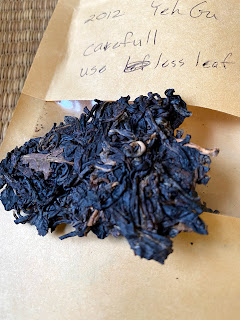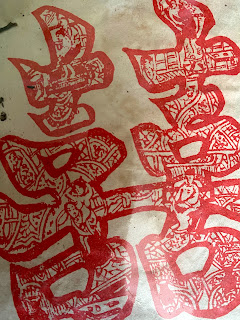Kunming dry stored for whole life- check.
Super crazy tight compression- check.
BuLang Bulang-E-ness- check.
While this one checks a lot of boxes for me. The description on Yunnan Sourcing’s site
says that good ol’ Hai Lang picked this up in Menghai in 2000. It currently goes for $102.00 for 250gmushroom or $0.41/g a price determined by Hai Lang Hao and passed on to us by
Yunnan Sourcing. Yunnan Sourcing has many options for Bulang puerh. This one
seemed to be the most interesting to me so I picked up a sample…
Dry leaves smell of classic smokey barely sweet fruit odour.
First has a nice mellow very faint smoke with mainly sweet
tasting thin layer of dried pear, and a base of wood. The mouthfeel is slightly sticky and sandy
with the sensation more on the tongue than in the throat.
The second has a nice sweet approach with a very faint mild
woody smokiness left. The taste is mainly this monotone sweetness that is
almost a woody, grassy, and non-distinct almost not-really there dried pear
taste. There is faint smoke on the
breath.
The third gains a bit of strength as a slight bitterness
where a sweet grassy woodiness comes out.
The sweet fruitiness is overtaken by bitter and woody grass here. There is a nice powdery dry storage nuance in
here now. There is a deep underlying
menthol that start to generate over a flat sandy stimulating tongue feeling and
less active throat. A very faint candy
breath can be found.
The fourth develops a rich nutty sweet onset that is mainly
sweet but in a nutty and rich woody type of way. There is a deep underlying pungency which pushes
an almost cherry like sweetness out in the breath. The mouthfeel is this almost sandy full
tongue sensation that is not overpowering but still significant. The aftertaste turns into a longer running
sweetness. The smokiness is pretty much
non-existent now.
The fifth has a thick mushroom almost pecan onset with
grassy woodiness underneath. The overall
taste is sweet but it’s hard to describe it almost like a dried/ dehydrated
pear sweetness that melds with the mushroom, nutty, woody and grassiness. There is a slight richness to the taste. The mild building pungency is apparent in the
aftertaste that pushes out a mild candy sweetness. The smokiness is pretty mild and more in the
aftertaste.
The sixth infusion has a mild bitterness with woody and
mushroom and it turns into a nice sweetness. The sweetness is almost a nutty rich sweetness
like how a nut butter is sweet. The
mouthfeeling is full and kind of a dry tight mild coating especially on the
tongue. The throat is more opening at
the top and mid level. There is an
extension of the sweetness in the aftertaste as a powdery almost cherry like
and very faint candy lingering on the breath.
The overall taste is rich, warming, clean, woody and mushroom almost but
not really dried pear. The Qi is mildly
relaxing.
The seventh infusion has a woody rich menthol onset with a
strong nuttiness in there as well. There
is barely any bitterness here more of a grassy woody menthol type with a strong
clear almost plum richer sweetness. There is some candy on the breath and a
good powdery-ness in there as well.
The eighth infusion has a very woody lumber rich taste to it. There is a honey almost smoked maple syrup
edge to it. The mouthfeel is slightly
sandy and dry on the tongue but feels somewhat full. There isn’t really a
bitterness now its more of a drier, sharper finish. This infusion has a nice mild powdery cherry
nuance. The Qi is a moderate harmonious Qi not a typical strong Bulang Qi
sensation.
The ninth has a sandalwood taste with mushroom and sweetness
to it. The sweetness is hard to describe
it taste so blended into the profile it feels like sweet wood. The mouthfeel is slippery and thicker. The menthol incense wood nuance is nice and echoes
deep into the throat. Dry menthol wood
and mild sweetness.
The tenth has a sweet dense dry woody presentation. The taste is almost a syrupy maple syrup
taste intertwined with wood tastes. The
mouthfeel is a powdery, dry, sandiness on the tongue. The Qi is super mild but really harmonious it
is a touch alerting and a touch relaxing.
The tea feels really nice in the body, gentle but I can feel something
relax my face. It has a cozy aged warmth
to it. Smoke is gone now. The fruity aftertaste is long on the
breath. There is nice cherry powdery
fruity tastes here.
The 11th infusion has woody sweetness, at times
it almost seems like dry pear there is this low reaching pungency to the taste
which pushes out a faint sweetness on the breath. Overall this puerh feels somewhat dense, full
and complete but harmonious in the body and mind.
The 12th infusion has a strong woody with faint
smokey nuance. The taste is full and
tastes of woody notes and chestnuts. The
Qi makes me feel good. Relaxed and content.
The 13th infusion has a pine wood taste to it
with a pungent sweetness that emerges in the aftertaste. The mouthfeel is really stable throughout all
the infusions it remains full and a sticky powdery sandy on the tongue.
The 14th has a fruity mainly woody mushroom onset. Still full mouthfeeling with a low rising
pungency and a bit of sweetness under wood mushroom to finish. There is a flat woodiness throughout
now.
The 15th infusion has a pine woody sweetness the
taste is really dense and feels full on the mouthcoating. This is a nice harmonious jincha. The low lying pungency is nice and pushes
some sweetness out of the woodiness.
There is a nice peachy sweetness pushed out somehow.
I put this one into overnight steeping as I run out of time
in my day…
This one tastes like a bit of a sweeter, lighter Bulang with
a mild suggestion of a more bitter and sweet with distant smokey classic Bulang
nuance. This is partly because the
bitterness and smoke have aged out a bit and the dry storage and compression is
favorable for the sweetness. This Bulang
has a really mellow Qi sensation even for a two decade aged Bulang. The Qi is not typical of my experience of
Bulang. Either way it works nicely.. for a nice easy drinking dry aged puerh.
In some ways this mushroom reminds me of a bit of the Bada
puerh producing region with a mild sweet profile and nice mellow Qi. I don’t know that I’ve ever tried an aged
Bulang that tasted this mild and smooth.
There is something satisfying about this. On the plus side the dry storage tastes of
candy and sweet flavours are nice to behold in something like this due to its
nice dry storage. The storage of this
mushroom is ideal Kunming dry storage.
Nicely tight compressed. I think
the storage and compression work well for a lighter and sweeter Bulang like
this. I think this is fair price for
what you get considering this is 20 years aged nicely dry Kunming stored
puerh. For me it’s an easy drinker
Bulang- just not exactly what I’m looking for. Anyone
interested in clean dry storage on a truly aged Bulang with a smooth mild
presentation should give it a try.
Peace
























